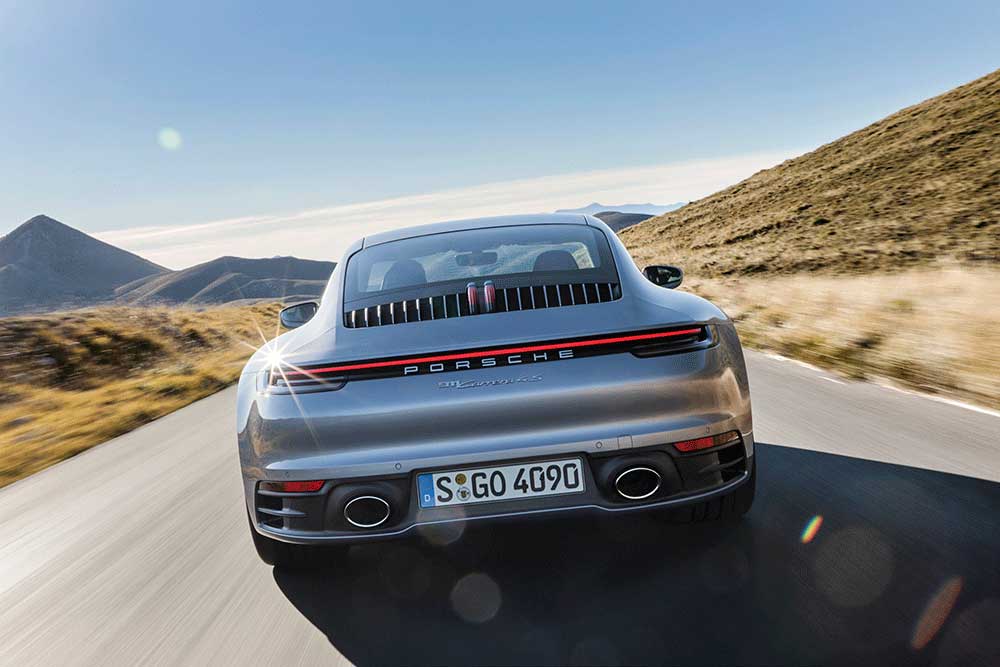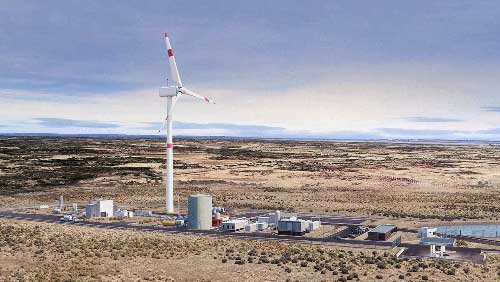Porsche backs e-fuel to keep its classics rolling

Like most car makers, Porsche has committed billions to the electrification of its vehicles, with the company stating 50% of all its new models to be battery electric by 2025 and setting a target of being CO2 neutral across its entire value chain by 2030.
But the goal of achieving CO2 neutral poses problems for a car maker that relies heavily on motorsport to build its brand and it has ramifications for its global fleet of older internal-combustion-powered vehicles, whose continued presence on road and track contribute to Porsche’s cachet and continued appeal.
Hence why the German sports car manufacturer and its partners have begun construction of what it claims is the world’s first integrated commercial plant for producing "nearly CO2-neutral fuel" in Chile.
With about 70% of all Porsches ever built still on the road today, the development of a viable renewable fuel source is a vital step in ensuring the future of these older models in a world where emissions regulations are bound to tighten, as well as the ongoing success of the international Porsche Mobil 1 Supercup racing series.
Porsche claims the development and use of e-fuel will make it possible to reduce fossil CO2 emissions in combustion engines by up to 90% and plans to use the first fuel from the Chilean plant in its Supercup series from 2022.
The international one-make racing premier series supports the FIA Formula One World Championship and usually has a round in Australia to accompany the Australian Grand Prix.
A statement from Porsche said the prestige car maker and Siemens Energy had joined forces with several international companies to build the industrial plant to produce e-fuel in Punta Arenas, Chile, at a site known as Haru Oni.
The ground-breaking ceremony for the pioneering project took in mid-September with a pilot plant to be initially built, which is expected to produce about 130,000 litres of e-fuels in 2022.
The capacity will then be expanded in two stages to about 55 million litres by 2024 and to about 550 million litres by 2026, according to a statement from Porsche.
As the fuel’s primary user, Porsche is planning in the first phase to use the e-fuels in its motorsport fleet, at Porsche Experience Centres and, later, in series production sports cars.
The sports car maker will start with an initial investment of about $32 million.
"Porsche was founded with pioneering spirit. That’s what drives us, we thrive on innovation," Member of the Executive Board for Research and Development at Porsche AG, Michael Steiner, said.
"We also see ourselves as pioneers when it comes to renewable fuels, and we want to drive development forward.
"This fits in with our clear overall sustainability strategy. It means that Porsche as a whole can be net CO2-neutral as early as 2030.
"Fuels produced with renewable energy can make a contribution to this.
"Our icon, the 911, is particularly suitable for the use of e-fuels.
"But so are our much-loved historic vehicles, because around 70% of all Porsches ever built are still on the road today.
"Our tests with renewable fuels are going very successfully."

Chile set itself ambitious targets as part of its National Green Hydrogen Strategy.
It aims to produce the world’s cheapest hydrogen and develop the country into a leading exporter of green hydrogen and its derivatives.
Australia is also positioning itself to be a global leader in hydrogen production and, like Chile, has an abundance of natural resources to make this possible.
Siemens Energy has already started preparatory work for the next major commercial phase of the Haru Oni project.
The company said the project would use strong winds in Chile’s Magallanes region to generate climate-neutral fuel.
Due to the excellent wind conditions and the resulting low cost of electricity, Chile has very high potential for the production, export and local use of green hydrogen, according to Siemens.
The company said liquid fuel exports were the best way to take advantage of the wind energy readily available in the region.
"I’m pleased that we’re making progress on this international lighthouse project for the hydrogen economy, together with strong international partners from business and politics," EVP for New Energy Business at Siemens Energy, Armin Schnettler, said.
"We’re jointly developing and realising the world’s first integrated and commercial large-scale plant for producing synthetic, climate-neutral fuels.
"In southern Chile, we’re implementing one of the energy industry’s most exciting projects for the future and driving forward the decarbonisation of the mobility sector.
"It means we’re making an important and rapidly effective contribution to reducing CO2 emissions in the traffic and transport sector."
Synthetic fuel such as that to made at Haru Oni is produced from water, wind energy and CO2 captured from the air.
It is a liquid energy carrier that emits about 90% less CO2 than the fossil counterpart.
In the case of e-gasoline, it is simultaneously compatible with existing liquid fuel infrastructure.
In the first step, electrolysers split water into oxygen and green hydrogen using wind power.
CO2 is then filtered from the air and combined with the green hydrogen to produce synthetic methanol, which in turn is converted into e-fuel.
The pilot plant is scheduled to start production in mid-2022.
In addition to Siemens Energy, Porsche and HIF, Enel, ExxonMobil, Gasco and ENAP are participating in the Haru Oni project.
Related topics
Things to note
The information in this article has been prepared for general information purposes only and is not intended as legal advice or specific advice to any particular person. Any advice contained in the document is general advice, not intended as legal advice or professional advice and does not take into account any person’s particular circumstances. Before acting on anything based on this advice you should consider its appropriateness to you, having regard to your objectives and needs.
Insurance Products (excluding Travel Insurance) are issued by RACQ Insurance Limited ABN 50 009 704 152 (RACQI) and arranged by its agent, RACQ Distribution Services Pty Ltd (RDS) ABN 35 116 361 650, AFSL 567130 and RDS' authorised representatives (including RACQ Operations Pty Ltd ABN 80 009 663 414, AR No. 234978 (RACQO). Conditions, limits and exclusions apply. RDS and RACQO are in the RACQ group of companies. One of the companies in the RACQ group of companies has a minority shareholding in RACQI.
RDS and RACQO have not taken your personal objectives, circumstances or needs into account when preparing advice regarding insurance products and you will need to consider whether the advice is appropriate for you. Read the Product Disclosure Statement (PDS) and any applicable Supplementary PDS before making a purchase decision on this product. You can also access our Target Market Determinations on this website. RDS receives a commission from RACQI for the policies it arranges. RACQO receives fees paid for services it provides to RDS. Further details about remuneration are available on request prior to purchasing.
Banking and loan products issued by Members Banking Group Limited ABN 83 087 651 054 AFSL/Australian credit licence 241195 trading as RACQ Bank. Terms, conditions, fees, charges and lending policies apply. This is general advice only and may not be right for you. This information does not take your personal objectives, circumstances or needs into account. Read the disclosure documents for your selected product or service, including the Financial Services Guide and the Terms and Conditions, and consider if appropriate for you before deciding.
Except for RACQ Bank, any RACQ entity referred to on this page is not an authorised deposit-taking institution for the purposes of the Banking Act 1959 (Cth). That entity’s obligations do not represent deposits or other liabilities of RACQ Bank. RACQ Bank does not guarantee or otherwise provide assurance in respect of the obligations of that entity, unless noted otherwise.
RACQ Bank subscribes to the Customer Owned Banking Code of Practice which establishes higher standards than the law requires. The Code reflects modern consumer expectations and developments in approaches to issues such as consumer vulnerability, guarantors, and supporting customers through financial hardship. Please read our Customer Owned Banking Code of Practice page for more information.
RACQ Operations Pty Ltd (ABN 80 009 663 414 AR 000234978) and Members Travel Group Pty Ltd (ABN 45 144 538 803 AR 000432492) are acting as an Authorised Representative of the issuer of the insurance, Tokio Marine & Nichido Fire Insurance Co., Ltd. (ABN 80 000 438 291 AFSL 246 548). Any advice set out above is general in nature only, and does not take into account your objectives, financial situation or needs. Before purchasing any travel products, please consider the RACQ Travel Insurance Product Disclosure Statement (PDS) and the Target Market Determinations (TMDs) that apply to these products. Whilst the PDS outlines the Terms and Conditions of these products, the TMDs outline the intended class of customers that comprise the target market for these travel products. This will allow you to consider which products best suit your objectives, financial situation and needs and consider the products appropriateness to your personal circumstances. TMDs also outline matters involving the distribution and the review of these products. The PDS, Supplementary PDS and TMDs for each travel product can be found here.
